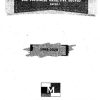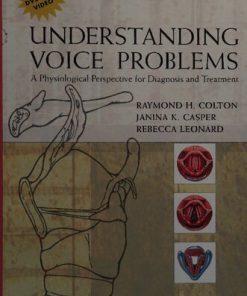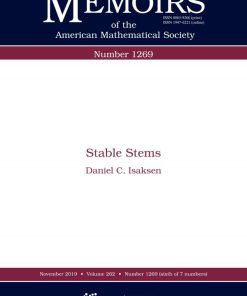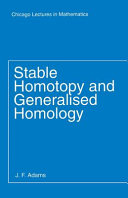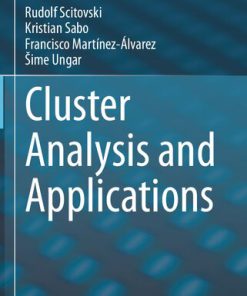Extension Problems and Stable Ranks A Space Odyssey 1st Edition by Raymond Mortini, Rudolf Rupp ISBN 9783030738723 3030738728
$50.00 Original price was: $50.00.$25.00Current price is: $25.00.
Extension Problems and Stable Ranks A Space Odyssey 1st Edition by Raymond Mortini, Rudolf Rupp – Ebook PDF Instant Download/Delivery: 9783030738723 ,3030738728
Full download Extension Problems and Stable Ranks A Space Odyssey 1st Edition after payment
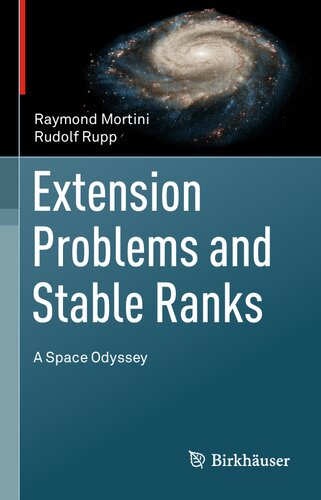
Product details:
ISBN 10: 3030738728
ISBN 13: 9783030738723
Author: Raymond Mortini, Rudolf Rupp
Extension Problems and Stable Ranks A Space Odyssey 1st Edition Table of contents:
Part I Topological structures and Banach algebras
Chapter 1 A short introduction into point-set topology
1.1 Compact and connected spaces
1.1.A Basic topological notions
1.1.B Discrete subsets in topological spaces
1.1.C Compact sets
1.1.D Exhaustion sequences in Rn
1.1.E Separable metric spaces
1.1.F Baire spaces
1.1.G Continuous functions between general topological spaces
1.1.H Connected sets
1.1.I Connected components
1.1.J Compact connected sets
1.1.K Simply connected planar domains
L Perfect sets
1.2 The axiom of choice and Zorn’s Lemma
1.2.A The size or cardinal of some distinguished sets
1.3 Nets and compactness
1.3.A Nets in topological spaces
1.3.B Subnets
1.4 Filters and compact sets
1.5 Lindelöf spaces
1.6 Infinite products of topological spaces
1.6.A Basic properties of infinite products
1.6.B Tychonov’s theorem
1.6.C Countable products of metric spaces
1.6.D Completely metrizable spaces
1.6.E The Alexandroff-Hausdorff theorem
Chapter 2 The Tietze extension theorem
Chapter 3 Smooth functions and Lebesgue measurable sets
3.1 Smooth partitions of unity
3.2 Interpolation and approximation by smooth functions
3.2.A Interpolation and zero sets
3.2.B Friedrich mollifiers and approximation
3.3 Smooth extensions
3.4 Rudiments of measure theory
3.4.A Lebesgue-measurable sets
3.4.B Measurable functions
Chapter 4 The ∂bar-calculus
4.1 The Wirtinger derivatives
4.2 Some basics in function theory/complex analysis
4.3 Planar Cauchy integrals and the dbar-equation
4.4 The Cauchy, Gauss, Green, Stokes, and Pompeiu formulas
4.5 Weak solutions of the ∂-equation
4.6 Explicit values of some integrals
4.6.A Planar Cauchy integrals
4.6.B Other types of planar integrals
Chapter 5 Approximation theorems
5.1 The Runge approximation theorems
5.1.A Approximation by rational functions
5.1.B The polynomial convex hull
5.2 The ∂bar-equation revisited
5.3 Montel’s approximation theorem
5.4 The Stone-Weierstrass approximation theorem
5.5 Compactness criteria in function spaces
5.5.A The Arzelà-Ascoli theorems
5.5.B Montel’s criteria for normality
Chapter 6 Maximum principles, integral formulas, and Blaschke products
6.1 Maximum principle for holomorphic functions in several complex variables
6.2 Cauchy and Poisson representations
6.3 Holomorphic functions with smooth boundary values
6.4 Poisson representation on half-planes
6.5 The argument principle
6.5.A Winding numbers, roots and logarithms
6.5.B Index of maps on the unit circle and the winding number
6.6 Blaschke products
6.6.A Blaschke products and Riesz factorization
6.6.A.1 The pseudohyperbolic distance
6.6.A.2 Infinite products and Blaschke products
6.6.B Cluster sets
Chapter 7 Banach algebra techniques
7.1 Basics in linear algebra and functional analysis
7.1.A Linear maps and norms
7.1.B Finite-dimensional normed spaces
7.1.C Extension theorems for linear functionals
7.1.D Quotient spaces
7.1.E The open mapping theorem
7.1.F Projections and complemented subspaces
7.2 Basic theory of Banach algebras
7.2.A Renormings and examples of Banach algebras
7.2.B Completions of normed algebras
7.2.C The spectrum of a Banach algebra element
7.2.D Commutative Banach algebras
7.2.E The maximal ideal space or spectrum of a Banach algebra
7.2.F Separability and metrizability of spectra
7.2.G The spectrum of several classical Banach algebras
7.2.H The Gelfand transform
7.2.I Semi-simple algebras
7.2.J Uniform algebras and function algebras
7.2.K Natural Banach function algebras
7.3 Finitely generated Banach algebras and joint spectra
7.3.A Joint spectra
7.3.B The basic theory on finitely generated Banach algebras
7.3.C Polynomial convexity in Cn
7.4 The Shilov boundary
7.4.A Minimal closed boundaries
7.4.B The Shilov extension theorem
7.5 The A-convex hull, L-sets and support sets
7.5.A The A-convex hull
7.5.B L-sets and the A-rational convex hull
7.5.C Support sets for characters
7.6 The holomorphic functional calculus
7.6.A The one-dimensional functional calculus
7.6.B The holomorphic functional calculus II
7.7 Exponentials and logarithms in Banach algebras
7.7.A Exponentials in general Banach algebras
7.7.B Exponentials and logarithms in the matrix algebra
7.7.B.1 The algebra Mn(K)
7.7.B.2 The matrix algebra Mn(A)
7.7.B.3 The exponential of a matrix in M(A)
7.7.B.4 Logarithms of the identity matrix in M2(A)
7.7.B.5 Logarithms of triangular matrices in M(A)
7.7.B.6 Representations with few exponential matrices
7.8 Invertible tuples in a unital Banach algebra
7.8.A The connected components of Un(A)
7.8.B The Arens-Royden-Novodvorski-Taylor theorems
7.9 The group of units in the algebra C(T,C)
7.10 Real Banach algebras
7.10.A Complexifications of real algebras
7.10.A.1 Ideals in real algebras and their complexifications
7.10.B The real-symmetric spectrum of elements in real Banach algebras
7.10.C Real division algebras
7.10.D Functional calculus for real Banach algebras
7.10.E Maximal ideals and characters of real Banach algebras
7.10.E.1 The complexification of the algebra CR
7.10.E.2 The Gelfand transform in real Banach algebras
7.10.E.3 Some relations between the invertible tuples of a real Banach algebra and its complexificat
7.10.F Semi-simple algebras and the real Arens-Royden theorem
7.10.G The Shilov idempotent theorem for real Banach algebras
7.10.H Different levels of reality
7.10.I Natural real Banach function algebras
Chapter 8 The Stone-Čech compactification and extension of maps
8.1 Completely regular spaces
8.2 Compactifications
8.2.A The Stone-Čech compactification
8.2.B The Alexandroff compactification
8.3 Extensions of maps from dense subsets
Chapter 9 Nonunital Banach algebras
9.1 Adjoining an identity element
9.2 Bounded approximate identities
9.2.A Bounded approximate identities
9.2.B Cohen’s factorization theorem
9.3 Spectra and maximal ideals
9.3.A Spectra of nonunital Banach algebras and one-point compactications
9.3.B Maximal ideals in nonunital Banach algebras
9.3.C Direct products of Banach algebras
9.3.D Banach algebras with empty spectrum
9.3.E Nonunital Banach algebras with compact spectrum
9.3.F Maximal ideals in Banach algebras II
9.3.G Radical and hyperradical algebras
9.3.H The Volterra and Dales algebras
9.3.I Ideals not contained in any maximal ideal
Chapter 10 Brouwer’s fixed point theorem
10.1 The fixed point theorem
10.2 Non-extendability
10.3 Extensions, retracts and homotopy
10.4 The hairy ball theorem
10.5 The Borsuk-Ulam theorems
Chapter 11 Extension problems in Rn and mappings into the sphere
11.1 Self-mappings of the sphere
11.2 More general extension problems
Chapter 12 Topology in the plane: a function theoretic approach
12.1 Zero-free extensions, logarithms, and Eilenberg’s Theorem
12.2 Simple connectivity and logarithms on open sets
12.3 Harmonic functions and logarithms
12.4 The open mapping theorem for injective maps
12.5 Unbounded continuous logarithms
12.6 The Jordan curve theorem
12.6.A The complementary components of a Jordan curve
12.6.B Three Applications of the Jordan curve theorem
12.7 Level sets
12.8 Rouché type theorems
12.8.A Counting zeros and poles
12.8.B A homotopic variant of Rouché’s theorem
12.8.C Rouché for continuous-holomorphic pairs
12.8.D Rouché in abstract Banach algebras
Chapter 13 Local and simple connectedness, curves, arcs, and continua
13.1 Peano curves
13.2 Locally connected spaces
13.3 The Hahn-Mazurkiewicz theorem
13.4 Metric continua
13.4.A Local connectedness versus local path-connectedness
13.4.B A characterization of Jordan arcs and Jordan curves
13.4.C Local connectedness versus local arc-connectedness
13.4.D Jordan arcs passing through prescribed points
13.5 Connectivity: examples and counterexamples
13.6 Homotopies of curves
13.7 The continuous lifting theorem and logarithms on psc-spaces
13.8 Simply connected planar domains: a résumé
13.9 The Pochhammer curve
Chapter 14 Continuous extensions of conformal maps and homeomorphisms
14.1 Extensions of conformal maps
14.2 Extension theorems of Schoenflies type
14.3 The Schwarz reflection principle
14.4 A conformal map with strange properties
14.5 Interpolation by homeomorphisms
Chapter 15 Advanced function-theoretic tools
15.1 Normal families of holomorphic functions revisited
15.2 Montel’s normality criterion via conformal metrics
15.3 The Ahlfors-Shimizu characteristic and normal functions
Chapter 16 Borsuk’s extension theorem
16.1 Retracts, fixed points and contractibility
16.2 The extension theorem
Chapter 17 Dimension theory
17.1 Dimension of normal spaces
17.2 The topological dimension and extension properties
17.3 Some distinguished properties for the covering dimension
17.4 The covering dimension of Rn
17.5 The dimension of the Stone-Čech compactification
17.6 Spaces of dimension 0 and total disconnectedness
17.6.A The relations
17.6.B Examples of connected and totally disconnected sets in R2
17.6.C The dimension of topologically thin subsets in Rn
17.6.D Cantor sets and zero-dimensionality
17.7 The Stone-Cech compactification of the integers
Chapter 18 Michael’s selection theorem
18.1 Michael’s theorem for compact spaces
18.2 Right inverses in functional analysis
Part II Algebraic structures
Chapter 19 Algebraic preliminaries
19.1 Maximal ideals and prime ideals
19.2 Nakayama’s lemma
19.3 PIDs and UFDs
Chapter 20 The Bézout equation
20.1 The solution set
20.2 Some examples
20.2.A The polynomial ring C[z]
20.2.B The ring H(U) of holomorphic functions
20.2.C The Bézout equation in C[z] with degree estimate
20.2.D The Bézout equation for rational functions
20.3 The Bézout equation in general function algebras
Chapter 21 The algebras Cb(X,K) and C(X,K) on non-compact spaces
21.1 Maximal ideals in C(X,K)
21.2 Free ideals
21.3 The inner and outer corona
21.4 Maximal ideals in C(X,K) versus Cb(X,K)
21.5 The Q (or realcompact) spaces
Chapter 22 Polynomial, Noetherian, and von Neumann regular rings
22.1 Euclidean division
22.2 Noetherian rings and minimal prime ideals
22.3 Hilbert’s Nullstellensatz
22.4 The polynomial ring R[x1, … , xn]
22.4.A Generators for maximal ideals in real polynomial rings
22.5 Algebraic dependence of polynomials
22.6 The Krull dimension of polynomial rings over fields
22.7 Krull’s intersection theorem
22.8 Von Neumann regular rings and zero-dimensional rings
Chapter 23 The Bass and topological stable ranks
23.1 Some fundamental properties of the stable ranks
23.2 Stable ranks in the nonunital case
23.3 Reducibility in C(M(A),C) versus reducibility in A
23.4 Reducibility to the principal component
23.5 Stable rank and Krull dimension
23.5.A Stable rank of Noetherian rings
23.5.B Bézout domains
Chapter 24 The stable ranks for algebras of polynomials and entire functions
24.1 The algebras C[z], H(U), and R0(K)
24.2 Real- and complex-valued polynomials
Chapter 25 The Bass and topological stable ranks of C(X,K)
25.1 Vasershtein’s Theory
25.2 Examples of non-reducible tuples
25.3 Reducibility in C(X,K)
25.3.A Reducibility versus extensions
25.3.B Reducibility of pairs and the boundary principle
25.3.C Reducibility of tuples in the several variables setting
25.3.D Complex Banach algebras with spectrum in Cn
25.4 Stable ranks of subrings of C(X,K)
25.4.A Conditions for equality
25.4.B Subalgebras of C(X, K) with prescribed stable ranks
25.5 Mappings between spheres
25.5.A Applications to totally disconnected sets in Rn
Chapter 26 The planar algebras P(K), R(K), A(K), C(K), and their siblings
26.1 The disk algebra
26.1.A The Herglotz kernel and the conjugate Poisson kernel
26.1.B Zero sets and interpolation in A(D)
26.2 Some approximation theorems relating P(K), R(K), A(K), and C(K)
26.3 Generators for P(K), R(K), A(K), and C(K)
26.3.A R(K) is two-generated
26.4 Injective holomorphic extensions of P(K)-functions
26.5 Algebraic properties: spectra and Bézout equation
26.5.A Stability of algebras on planar sets
26.5.B The algebra P(K)
26.5.C A constructive proof of the Nullstellensatz for A(D)
26.5.D The cylinder algebra and parametrized families of disk algebra functions
26.5.E The algebra R(K)
26.5.F The algebras A(K) and A(G)
26.5.G The Nullstellensatz for A(S,K)
26.5.H The Nullstellensatz for subalgebras of A(K)
26.5.I The algebra A1(K)
26.6 The Shilov boundaries for P(K), R(K), A(K) and beyond
26.7 The stable ranks of C(K)
26.7.A Sard’s lemma
26.7.B The stable ranks of C(K) revisited
26.8 The stable ranks for P(K), R(K), A1(K)
26.8.A The stable ranks for R(K) and P(K)
26.8.B The stable ranks for the cylinder algebra
26.8.C The stable ranks for A1(K)
26.9 The stable ranks for A(K), A(G) and A(S,K)
26.10 Stable ranks for subalgebras of A(K)
26.11 The spectrum and stable ranks for M(K)
Chapter 27 The algebra of bounded analytic functions
27.1 Fatou-Lindelöf theorems
27.1 Some uniqueness theorems and trigonometric series
27.3 Interpolation problems
27.3.A Interpolation of boundary data by finite Blaschke products
27.3.B Interpolating sequences
27.3.C Perturbation of interpolating sequences and approximative interpolation
27.3.D Interpolating Blaschke products
27.3.E Finite unions of interpolating sequences
27.3.F Interpolation on Carleson-Newman sequences
27.3.G Special interpolation sets in M(H)∞
27.3.H The interpolation sets for the disk algebra
27.4 The algebra of essentially bounded functions
27.4.A Bounded measurable functions
27.4.B Essentially bounded functions
27.5 Hardy spaces on the circle and disk
27.5.A Boundary values of bounded analytic functions
27.5.B Basic results in Hp-theory
27.5.B.1 The Hardy-Hilbert space H2( D)
27.5.B.2 The Hardy space H1( T) and some dual spaces
27.5.B.3 The spaces Hp( D) and Hp( T)
27.5.B.4 The Fejér-Riesz, Hilbert, and Hardy inequalities
27.5.B.5 Harmonic conjugates, Fourier series and the Gleason-Whitney theorem
27.5.C Inner-outer factorization in Hardy spaces
27.6 The uncomplementedness of the disk algebra
27.7 The functions exp[(1+z)p/(1-z)p] for p=2,4
27.8 The spectrum of H∞ and the Corona Theorem
27.8.A The proof of the corona theorem
27.8.A.1 Littlewood-Paley-type inequalities
27.8.A.2 Estimating solutions to the -equation
27.8.A.3 The proof of the corona theorem via a -problem with bounds
27.8.B Additional properties of H( D) and its spectrum.
27.9 The Sarason algebra
27.9.A The spectrum of the Sarason algebra
27.9.B The stable ranks for the Sarason algebra
27.10 Non-tangential limits
27.10.A Hardy-Littlewood maximality and Fatou’s theorem
27.10.B The Axler-Shields-Ivanov extension theorem
Chapter 28 Peak sets in function algebras
28.1 Peak sets and peak points
28.2 The Jarosz algebra and its peak points
Chapter 29 Lipschitz algebras
29.1 Basic properties of Lipschitz algebras
29.1.A Holomorphic Hölder-Lipschitz algebras
29.1.B The Hölder-Lipschitz algebra on the disk
29.1.C Extension theorems for Hölder-Lipschitz functions
29.1.D Pointwise Lipschitz functions
29.2 Algebraic properties of Lipschitz algebras
29.2.A Spectra of planar Lipschitz algebras
29.2.B Stable ranks of holomorphic Lipschitz algebras
29.3 Lipschitz classes on metric spaces
Chapter 30 Regular and normal Banach algebras
30.1 Normal subalgebras of C(X,K)
30.2 Stable rank of regular Banach algebras
Chapter 31 The stable ranks for a zoo of algebras
31.1 Lower and upper estimates for the stable ranks
31.1.A Lower estimates for the Bass stable rank
31.1.B Lower estimates for the topological stable rank
31.1.C Upper estimates for stable ranks
31.2 Stable ranks for algebras of smooth functions
31.2.A The algebra C∞(Ω,K)
31.2.B The algebra C∞bb(Ω,K)
31.3 Stable ranks of finitely generated Banach algebras
31.4 Two-generated algebras
31.4.A The cone algebra
31.5 Sequence algebras
31.6 The algebra of A-valued continuous functions
Chapter 32 Various notions of reducibility and stable ranks
32.1 The Bass stable rank via homomorphisms
32.1.A The surjective and dense stable rank
32.1.B Criteria for the connectedness
32.1.C The connected stable rank
32.1.D The stable ranks for homomorphic images of algebras
32.2 The dense stable rank of several classical algebras
32.2.A Vasershtein’s theorem revisited
32.2.B Regular and approximatively regular algebras
32.2.C The dense stable rank for subalgebras of A(K)
32.2.D The dense stable ranks of finitely generated Banach algebras
32.3 Three classes of stable ranks
32.3.A Unitary M-stable rank versus all-units rank
32.3.B Norm-one rank
32.4 Total reducibility
32.4.A Some sufficient conditions for total reducibility
32.4.B Total reducibility in H(U)
32.4.C Total reducibility in A(D)
32.4.D Exponential reducibility
32.5 The absolute stable rank
32.6 Generalized E-stable ranks
32.6.A E-stable rank and L-sets
32.6.B The E-stable rank of the disk algebra
32.7 Stable ranks of quotient rings and the almost stable rank
32.7.A Quotients of rings and the Bass stable rank
32.7.B The almost stable rank
32.7.C Calculating alsr for some rings
Chapter 33 Stable ranks of holomorphic function algebras in Cn
33.1 The dbar-calculus in several complex variables
33.1.A The chain rule for the dbar-calculus
33.2 The dbar-equation in polydisks
33.2.A Conditions for the existence of solutions to dbar f=u
33.2.B Hartogs phenomenon
33.3 The polydisk and ball algebras and beyond
33.4 The infinite polydisk algebra
33.5 The Bézout equation for entire functions
33.5.A Bézout equation for two generators
33.5.B Cartan’s Nullstellensatz for entire functions
33.5.C Stable ranks for H(Cn)
33.6 Subalgebras of A(D) via several complex variables
Chapter 34 Real-symmetric function algebras
34.1 Symmetric continuous functions
34.1.A Maximal ideals and the Bézout equation in C(X,tau)
34.1.B Asymmetric and -invariant sets
34.1.C The stable ranks for C(X,)
34.2 The algebra A( D)sym revisited
34.2.A Reducibility in A( D)sym
34.2.B The E-stable rank for A( D)sym
34.3 The real-symmetric algebra A(K)sym and its siblings
34.3.A Characters and ideals in real-symmetric function algebras
34.3.B Reducibility in real-symmetric function algebras
34.3.C Stable ranks of P(K)sym and R(K)sym
34.3.D The Bass stable rank for A(K)sym
34.4 Real-symmetric bounded analytic functions
Chapter 35 The algebra of almost periodic functions
35.1 Kronecker’s theorems in ergodic theory
35.2 Equidistributed sequences
35.3 Basic function theoretic properties of AP
35.4 Fourier-Bohr series
35.5 The Banach algebra AP
35.5.A The spectrum of AP
35.5.B The Bohr compactification as a group
35.5.C Interpolating sequences in AP
35.5.D The Bochner-Fejér operators
35.5.E Further algebraic properties of AP
35.6 AP+
35.6.A Function-theoretic properties of AP+
35.7 The stable ranks of AP and AP+
35.8 Subalgebras of AP
35.8.A Algebras of type AP-Lambda
35.8.B General subalgebras of AP
35.8.C Further examples of subalgebras of AP
Chapter 36 Matricial stable ranks
36.1 Some elementary matrix operations
36.2 Extension to invertible matrices
36.2.A The Hermite property
36.2.B The K-Hermite property
36.3 The stable ranks of non-commutative rings
36.3.A The Bass stable rank of matricial rings
36.3.B The topological stable rank of matricial rings
36.4 The Bézout equation in matricial rings
Part III The Appendix
Appendix A Some results in number theory and function theory
A.1 Frobenius numbers
A.2 An application of the Vandermonde matrix
A.3 Some trigonometric series
A.4 Absolute convergence of infinite products
A.5 An entire function with vanishing radial limits
A.6 A special Hölder-Lipschitz function
A.7 Conformal maps and the Riemann mapping theorem
A.8 The monodromy theorem
A.9 Convex sets in the plane
A.10 Branches of the inverse of cosh z
A.11 A brief glimpse on hyperbolic geometry
A.12 The chordal and spherical metrics
A.13 A criterion in real analysis for the existence of potentials
A.14 Poisson integral estimates
A.15 Some fascinating identities
A.16 A useful improper integral
A.17 Two elementary limits involving factorials
A.18 The Faà di Bruno formula
The Cantor sets
Appendix B The Lp( T)-spaces
Appendix C Matrix analysis
C.1 Differentiability and M-differentiability
C.2 Diagonalization and Elementary matrices
C.3 Exponentials and logarithms of matrices
C.4 Schur’s reduction theorem
C.5 Diagonal dominant matrices
Appendix D E-valued functions: integration and holomorphy
D.1 Riemann integrable functions with values in normed spaces
D.2 A-valued holomorphic functions
Appendix E Some tables
E.1 The Bass and topological stable ranks of various algebras/rings: a résumé
Appendix F Notes and Sources
Index
People also search for Extension Problems and Stable Ranks A Space Odyssey 1st Edition:
extended stable channel
an extension ladder should be positioned at what angle
extent of a problem
extension problem
Tags:
Raymond Mortini,Rudolf Rupp,Extension Problems,Stable Ranks,Space Odyssey
You may also like…
Engineering - Energy & Power Resources
Uncategorized
Relationships & Lifestyle - Health - Diseases & Disorders
Uncategorized
Mathematics - Geometry and Topology
Biography & Autobiography - Holocaust
Tehran Children A Holocaust Refugee Odyssey 1st Edition Mikhal Dekel
Computers - Computer Science
Uncategorized

